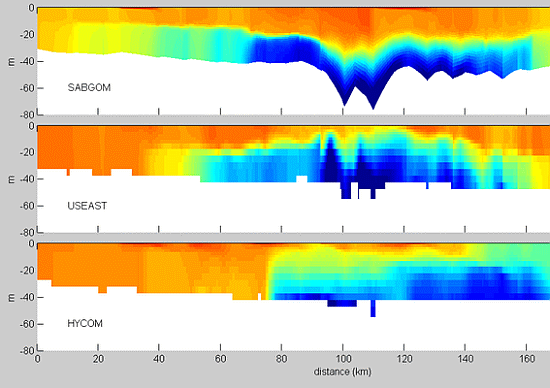Advances in a Distributed Approach for Ocean Model Data Interoperability
Abstract
:1. Introduction



2. Methods
2.1. IOOS COMT Model Data Interoperability Design
2.2. Advances in Model Data Standards, Tools and Techniques
2.2.1. The ncSOS Service for Observational Data
2.2.2. Unstructured Grid (UGRID) Standards and Tools


2.2.3. Expanded Analysis Functions and Demos in NCTOOLBOX for Matlab Users
2.2.4. An Improved Procedure for Modelers to Create Standardized Datasets
2.2.5. Enabling Discovery via Standardized Metadata and Catalog Services

2.2.6. CF Compliant Tools for Python

3. Conclusions
Acknowledgments
Author Contributions
Conflicts of Interest
References
- Willis, Z.; Manley, J. Ocean Observing: Delivering the Benefits. Mar. Technol. Soc. J. 2010, 44, 4–5. [Google Scholar] [CrossRef]
- Bassett, R.; Beard, R.; Burnett, W.; Crout, R.; Griffith, B.; Jensen, R.; Signell, R. Implementing the National Integrated Ocean Observing System (IOOS) From the Federal Agency Perspective. Mar. Technol. Soc. J. 2010, 44, 32–41. [Google Scholar] [CrossRef]
- de La Beaujardiere, J.; Mendelssohn, R.; Ortiz, C.; Signell, R. Building the IOOS Data Management Subsystem. Mar. Technol. Soc. J. 2010, 44, 73–83. [Google Scholar] [CrossRef]
- Ocean.US. The Integrated Ocean Observing System (IOOS) Modeling and Analysis Workshop Report; Ocean.US Publication No. 18; Ocean.US: Arlington, VA, USA, 22–24 July 2008; p. 21. [Google Scholar]
- Sherwood, C.R.; Book, J.W.; Carniel, S.; Cavaleri, L.; Chiggiato, J.; Das, H.; Doyle, J.D.; Harris, C.K.; Niedoroda, A.W.; Perkins, H.; et al. Sediment dynamics in the Adriatic Sea investigated with coupled models. Oceanography 2004, 17, 58–69. [Google Scholar] [CrossRef]
- Warner, J.C.; Sherwood, C.R.; Signell, R.P.; Harris, C.K.; Arango, H.G. Development of a three-dimensional, regional, coupled wave, current, and sediment-transport model. Comput. Geosci. 2008, 34, 1284–1306. [Google Scholar] [CrossRef]
- Signell, R.P.; Carniel, S.; Chiggiato, J.; Janekovic, I.; Pullen, J.; Sherwood, C.R. Collaboration tools and techniques for large model datasets. J. Mar. Syst. 2008, 69, 154–161. [Google Scholar] [CrossRef]
- Signell, R.P. Model Data Interoperability for the United States Integrated Ocean Observing System (IOOS). In Estuarine and Coastal Modeling (2009); Spaulding, M.L., Ed.; American Society of Civil Engineers: Reston, VA, USA, 2010; pp. 221–238. [Google Scholar]
- de La Beaujardière, J.; Beegle-Krause, C.; Bermudez, L.; Hankin, S.; Hazard, L.; Howlett, E.; Le, S.; Proctor, R.; Signell, R.P.; Snowden, D.; et al. Ocean and coastal data management. In Proceedings of OceanObs’09: Sustained Ocean Observations and Information for Society (Vol. 2), Venice, Italy, 21–25 September 2009; Hall, J., Harrison, D.E., Stammer, D., Eds.; European Space Agency Publication: Noordwijk, The Netherlands, 2010. [Google Scholar]
- Hankin, S.; Bermudez, L.; Blower, J.D.; Blumenthal, B.; Casey, K.S.; Fornwall, M.; Graybeal, J.; Guralnick, R.P.; Habermann, T.; Howlett, E.; et al. Data management for the ocean sciences—perspectives for the next decade. In Proceedings of OceanObs’09: Sustained Ocean Observations and Information for Society, Venice, Italy, 21–25 September 2009; Hall, J., Harrison, D.E., Stammer, D., Eds.; European Space Agency Publication: Noordwijk, The Netherlands, 2010. [Google Scholar]
- Luettich, R.A.; Wright, L.D.; Signell, R.; Friedrichs, C.; Friedrichs, M.; Harding, J.; Fennel, K.; Howlett, E.; Graves, S.; Smith, E. The US IOOS coastal and ocean modeling testbed. J. Geophys. Res. 2013, 118, 6319–6328. [Google Scholar] [CrossRef]
- Howlett, E.; Wilcox, K.; Crosby, A.; Bird, A.; Graves, S.; Maskey, M.; Keiser, K.; Luettich, R.; Signell, R.; Smith, L. The US IOOS Coastal and Ocean Modeling Testbed for Advancing Research to Applications. In Proceedings of Oceans, 2012, Hampton Road, VA, USA, 14–19 October 2012; IEEE: New York City, NY, USA, 2012; pp. 1–7. [Google Scholar]
- NcSOS Home Page. Available online: https://github.com/asascience-open/ncSOS (accessed on 25 February 2014).
- Unstructured Grid Interoperability Google Group Home Page. Available online: https://groups.google.com/d/forum/UGRID-interoperability (accessed on 25 February 2014).
- Unstructured Grid Metadata Conventions Home Page. Available online: https://github.com/UGRID-conventions/UGRID-conventions (accessed on 25 February 2014).
- Unstructured Grid Package for NetCDF-Java. Available online: https://github.com/asascience-open/NetCDF-Java-UGRID (accessed on 25 February 2014).
- NCTOOLBOX Toolbox for Matlab. Available online: https://github.com/nctoolbox/nctoolbox (accessed on 25 February 2014).
- Unstructured Grid Branch of NCTOOLBOX CF-Compliant Toolbox for Matlab. Available online: https://github.com/nctoolbox/nctoolbox/tree/UGRID (accessed on 25 February 2014).
- Blanton, B.; Signell, R.; Crosby, A.; Fleming, J.; Luettich, R. Federation of Coastal Storm Surge Forecasts using THREDDS, OPeNDAP and UGRID, a CF Extension for Unstructured Model Grids. In Proceedings of ESIP 2013 Summer Meeting, Chapel Hill, NC, USA, 9–12 July 2013.
- THREDDS Data Server Home Page. Available online: https://www.unidata.ucar.edu/software/thredds/current/tds/ (accessed on 25 February 2014).
- Blower, J.D.; Gemmell, A.L.; Griffiths, G.H.; Haines, K.; Santokhee, A.; Yang, X. A Web Map Service implementation for the visualization of multidimensional gridded environmental data. Environ. Model. Softw. 2013, 47, 218–224. [Google Scholar] [CrossRef]
- SciWMS Home Page. Available online: https://github.com/asascience-open/sci-wms (accessed on 25 February 2014).
- Wilkin, J.L.; Hunter, E.J. An assessment of the skill of real-time models of Mid-Atlantic Bight continental shelf circulation. J. Geophys. Res. 2013, 118, 2919–2933. [Google Scholar] [CrossRef]
- Globus Home Page. Available online: https://www.globus.org (accessed on 25 February 2014).
- Unified Access Framework Home Page. Available online: https://geo-ide.noaa.gov (accessed on 25 February 2014).
- Iris Home Page. Available online: http://scitools.org.uk/iris/docs/latest/index.html (accessed on 25 February 2014).
- Bergamasco, A.; Benetazzo, A.; Carniel, S.; Falcieri, F.; Minuzzo, T.; Signell, R.; Sclavo, M. Knowledge discovery in large model datasets in the marine environment: The THREDDS Data Server example. Adv. Oceanogr. Limnol. 2012, 3, 41–50. [Google Scholar] [CrossRef]
© 2014 by the authors; licensee MDPI, Basel, Switzerland. This article is an open access article distributed under the terms and conditions of the Creative Commons Attribution license (http://creativecommons.org/licenses/by/3.0/).
Share and Cite
Signell, R.P.; Snowden, D.P. Advances in a Distributed Approach for Ocean Model Data Interoperability. J. Mar. Sci. Eng. 2014, 2, 194-208. https://doi.org/10.3390/jmse2010194
Signell RP, Snowden DP. Advances in a Distributed Approach for Ocean Model Data Interoperability. Journal of Marine Science and Engineering. 2014; 2(1):194-208. https://doi.org/10.3390/jmse2010194
Chicago/Turabian StyleSignell, Richard P., and Derrick P. Snowden. 2014. "Advances in a Distributed Approach for Ocean Model Data Interoperability" Journal of Marine Science and Engineering 2, no. 1: 194-208. https://doi.org/10.3390/jmse2010194






